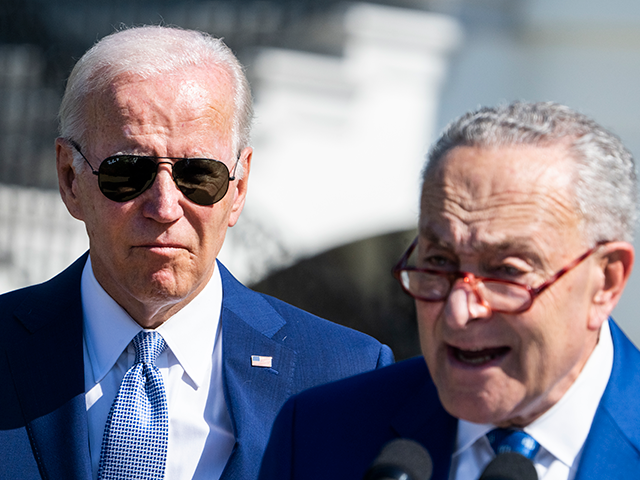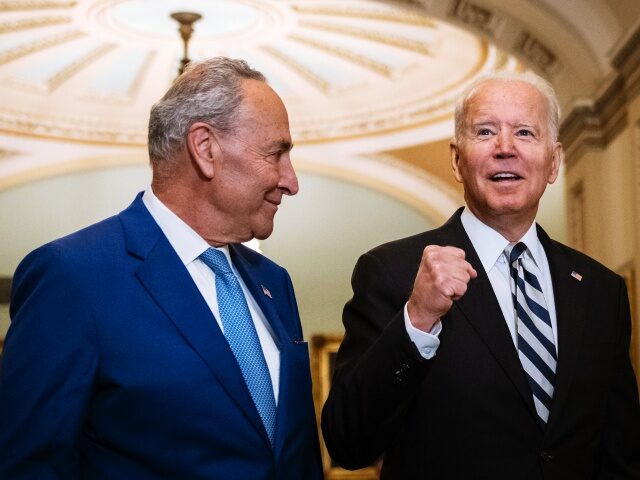U.S. inflation slowed in July by more than expected, prompting the Biden White House to announce Mission Accomplished.
“Before I begin today I want to say a word about the news that came out today relative to the economy. Actually, I just want to say a number: Zero. Today we received news that our economy had zero percent inflation in the month of July,” President Joe Biden said on Wednesday.
The idea that we had no inflation in July will come as a surprise to most Americans, who saw prices on most things they buy go up. The zero figure Biden is referring to comes from the fact that the headline Consumer Price Index was unchanged from the prior month, largely due to a steep decline in the price of gas. Excluding energy, consumer prices rose 0.4 percent in July compared with June. That will not feel like zero inflation to most Americans.
This is the Biden administration reverting to its preferred reaction to economic news: attempt to change reality by changing the description of reality. They love to quibble about the definition of recession, convinced that if they can mount a sophisticated enough argument that somehow Americans will be less unhappy about economic conditions—and presumably more willing to vote for Democrats in November. When inflation was being driven up by soaring gas prices, they told us to look at underlying inflation and not pay attention to “Putin’s price hikes.” Now that gas is pulling down headline inflation, the president takes to the national airwaves to declare inflation has fallen to nothing.

Senate Majority Leader Charles Schumer, D-N.Y., and President Joe Biden on Tuesday, August 9, 2022. (Tom Williams/CQ-Roll Call, Inc via Getty Images)
Falling back on this attempt to shape public perception through rhetoric is surprising because it has proven so ineffective. Fifty-eight percent of the public believes we are in a recession, according to a recent Economist/YouGov poll. Inflation is by far and away the number one issue in front of American voters. It’s hard to fool people about inflation because they see the prices of things they buy keep rising. Telling them that prices are not up at all just makes the White House appear to be out of touch with reality. Americans just are not going along for this kind of wishful speaking.
Let’s get some facts on the table. The Consumer Price Index is up 8.5 percent from a year earlier, the traditional way of looking at inflation, according to data released by the Department of Labor Wednesday. That represents a cooling of the 9.1 percent annual inflation in March that was the largest in four decades. It turns out, however, that if you exclude the most recent two months, this July figure is still the highest inflation in four decades. Core CPI, which excludes food and energy, rose 0.3 percent, the slowest pace in three months, and were up 5.9 percent compared with a year ago. Price hikes slowed in July but they didn’t stop.

Perhaps the most salient part of the Consumer Price Index apart from gasoline is the prices of food at home. Here we see that prices actually accelerated. Prices rose 1.3 percent, faster than last month’s one percent rise. Compared with a year ago, food prices are up 13.1 percent, the most since 1979. As we detailed today at Breitbart News, the prices of bread, milk, cereal, bacon, and ground beef continue to soar. Almost anywhere you go in the grocery store, prices are up from a month ago and have soared compared with a year ago. We like to point out that it is not just what you put on the kitchen table that is getting more expensive. The price of the table itself is surging higher, with the CPI index that includes kitchen and dining furniture up another 2.7 percent in July for a year-over-year gain of 20.8 percent.

The Biden administration should also be worried that this may be only a temporary respite. Gasoline prices have fallen because oil prices are down and demand for gasoline has apparently fallen. Even though we are in the summer driving season, demand for gasoline is down sharply compared to last year, according to the Energy Information Administration. In fact, the EIA says demand may be all the way down to what we saw in the lockdown summer of 2020. While some industry experts doubt demand is down by as much as reported, some decline makes sense. Surveys show that people report changing their driving habits to adjust to higher gas prices and high prices of other items—especially groceries—may be forcing people to cut back on driving where they can.
The decline in the price of gasoline may have helped fuel the rise in food prices. The excess demand created by too much money in the economy cannot be remedied by bringing down the price of a particular good. Instead, if you lower the price of gasoline, you usually wind up raising the price of something else.
Many on Wall Street are convinced that oil prices will head back up, especially if risks of recessions around the globe decline or China backs away from shutting down cities as part of its Zero Covid policy. Oil above $100 a barrel would send gasoline back up, reversing the decline in headline inflation seen in July.
The indicators of underlying inflation were not reassuring in July. Trimmed mean CPI, which excludes the most extreme upside and downside price changes in each month’s disaggregated inflation data, rose to a seven percent annual gain in July, up from 6.9 percent in June, according to the Federal Reserve Bank of Cleveland. Median inflation jumped to 6.3 percent from six percent. Both are considered more reliable indicators of future inflation than either headline or core CPI. Over time, headline CPI tends to converge with median and trimmed mean inflation, with the headline number headed toward where the median and trimmed mean numbers are, according to the Federal Reserve Bank of Dallas. So when these are headed higher, it is an indicator that where inflation will be in the future is higher than it was. Higher inflation, in other words, is becoming more entrenched in the economy.
We are glad inflation slowed in July. The CPI report is a welcome respite for an economy that had seen year-over-year inflation up in eight of the previous nine months. It may even provide the Federal Reserve with the chance to slow the pace of monetary tightening from the 75 basis point rate we saw in the last two months. The Biden administration, however, overplayed the good news by focusing on the unchanged month-over-month headline figure. Recall that last year, year-over-year inflation fell in July and August, prompting claims that inflation had peaked, only to start rising again in September.

If this month’s decline in the headline Consumer Price Index proves transitory, the Biden administration may well regret dancing a victory jig in front of the American public.

COMMENTS
Please let us know if you're having issues with commenting.